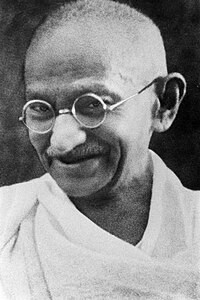| Mahatma Gandhi | |
|---|---|
 | |
| Born | Mohandas Karamchand Gandhi 2 October 1869 Porbandar, Kathiawar Agency, British Indian Empire[1] |
| Died | 30 January 1948 (aged 78) New Delhi, India |
| Cause of death | Assassination by shooting |
| Resting place | Cremated at Rajghat, Delhi |
| Other names | Mahatma Gandhi, Bapu, Gandhiji |
| Ethnicity | Gujarati |
| Alma mater | Alfred High School,
Rajkot, Samaldas College, Bhavnagar, University College, London (UCL) |
| Known for | Leadership of Indian independence
movement, philosophy of Satyagraha, Ahimsa or nonviolence. pacifism |
| Political movement | Indian National Congress |
| Religion | Hinduism, with Jain influences |
| Spouse(s) | Kasturba Gandhi |
| Children | Harilal Manilal Ramdas Devdas |
| Parents | Putlibai Gandhi (Mother) Karamchand Gandhi (Father) |
Mohandas Karamchand Gandhi ( 2 October 1869 – 30 January 1948) was the preeminent leader of Indian nationalism in British-ruled India. Employing nonviolent civil disobedience, Gandhi was one of the three key persons who led India to independence and inspired movements for civil rights and freedom across the world. He took the leadership of India's Freedom Movement at the end of its third phase. The honorific Mahatma ( Great soul an epithet given by Tagore) He is also called Bapu (Gujarati: endearment for "father," "papa.") in India.
Jawaharlal Nehru and Subhas Chandra Bose entered Indian politics in the Phase IV.
The son of Motilal Nehru, a prominent lawyer and nationalist statesman, Jawaharlal Nehru was a graduate of Trinity College, Cambridge and the Inner Temple, where he trained to be a barrister. Upon his return to India, he enrolled at the Allahabad High Court, and took an interest in national politics, which eventually replaced his legal practice. A committed nationalist since his teenage years, Nehru became a rising figure in Indian politics during the upheavals of the 1910s. He became the prominent leader of the left-wing factions of the Indian National Congress during the 1920s, and eventually of the entire Congress, with the tacit approval of his mentor, Gandhi. As Congress President in 1929, Nehru called for complete independence from the British Raj and instigated the Congress's decisive shift towards the left
Subhhas Chandra Bose joined Indian Politics in the IV Phase.
From the very beginning Subhas Chandra was not in favour of Gandhiji's plan and programme of "Swaraj in a Year", rather he was of opinion which led him, ultimately, to a direct fight with British Govt.. . He formed INA and took arms to achieve freedom of India.

No comments:
Post a Comment